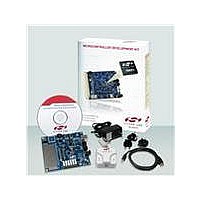C8051F800DK Silicon Laboratories Inc, C8051F800DK Datasheet

C8051F800DK
Specifications of C8051F800DK
Related parts for C8051F800DK
C8051F800DK Summary of contents
Page 1
C8051F800 Relevant Devices The C8051F800 Development Kit is intended as a development platform for the microcontrollers in the C8051F80x-83x MCU family. The members of this MCU family are ...
Page 2
C8051F800-DK Target Board R14 C8051F800-TB P1.4 CAPACITIVE SENSE P1.0_LED J3 D10 P1.0_LED P1.0 P1.1_LED P1.1 P1.5 P1.1_LED P1.2_LED P1.2 J7J6 D9 P1.3_LED P1.3 D4 P1.4_SW P1.4 P1.2_LED TX_MCU P0.4 D8 RX_MCU P0.5 RTS P1.5 P1.3_LED CTS P1.6 P1 ...
Page 3
CP210x USB to UART VCP Driver Installation The C8051F800 Target Board includes a Silicon Labs CP2103 USB-to-UART Bridge Controller. Device drivers for the CP2103 need to be installed before PC software such as HyperTerminal can communicate with the target ...
Page 4
C8051F800-DK 5.1.2. Getting Started With the Silicon Labs IDE The following sections discuss how to open an example project in the IDE, build the source code, and download it to the target device. 5.1.2.1. Running the F800_Blinky example program The ...
Page 5
Configuration Wizard 2 The Configuration Wizard code generation tool for all of the Silicon Labs devices. Code is generated through the use of dialog boxes for each of the device's peripherals. Figure 2. Configuration Wizard 2 ...
Page 6
C8051F800-DK 5.4. Programming Utilities The Silicon Labs IDE is the primary tool for downloading firmware to the MCU during development. There are two software programming tools that are intended for use during prototyping or in the field: the MCU Production ...
Page 7
TM 5.5. QuickSense Studio The QuickSense Studio software facilitates rapid code development and analysis for applications using the Silicon Labs family of QuickSense products. The Studio is comprised of multiple programs that guide users through an intuitive development flow, including ...
Page 8
C8051F800-DK 6. Example Source Code Example source code and register definition files are provided in the “SiLabs\MCU\Examples\C8051F80x_83x\” default directory during IDE installation. These files may be used as a template for code development. The comments in each example file indicate ...
Page 9
Target Board The C8051F800 Development Kit includes a target board with a C8051F800-GM device pre-installed for evaluation and preliminary software development. Numerous input/output (I/O) connections are provided to facilitate prototyping using the target board. Refer to Figure 4 for ...
Page 10
C8051F800-DK 7.1. Target Board Shorting Blocks: Factory Defaults The C8051F800 Target Board comes from the factory with pre-installed shorting blocks on many headers. Figure 5 shows the positions of the factory default shorting blocks. It should be noted that a ...
Page 11
Target Board Power Options and Current Measurement (P1, P2, J2, J4) The C8051F800 Target Board supports three power options VDC power using the power adapter (P1 VDC USB VBUS power from PC ...
Page 12
C8051F800-DK 7.4. Switches and LEDs (J3) Two push-button switches are provided on the target board. The switch labeled ‘RESET’ (SW1 in schematic) is connected to the reset pin (RST) of the C8051F800. Pressing this switch puts the device into its ...
Page 13
Target Board Debug Interface (J4) The DEBUG connector J4 provides access to the DEBUG (C2) pins of the C8051F800 used to connect the Serial Adapter or the USB Debug Adapter to the target board for in-circuit debugging ...
Page 14
C8051F800-DK 7.8. Analog I/O, Voltage and Ground Reference Options (TB1, J5, J10) Several of the C8051F800 target device’s port pins are connected to the TB1 terminal block. Refer to Table 4 for the TB1 terminal block connections. The J5 header ...
Page 15
Target Board Pin Assignment Summary Some GPIO pins of the C8051F800 MCU can have an alternate fixed function. For example, pin 17on the C8051F800-GM MCU is designated P0.4, and can be used as a GPIO pin. Also, if the ...
Page 16
C8051F800-DK 8. Schematics 16 Rev. 0.1 ...
Page 17
C8051F800-DK Rev. 0.1 17 ...
Page 18
... Should Buyer purchase or use Silicon Laboratories products for any such unintended or unauthorized ap- plication, Buyer shall indemnify and hold Silicon Laboratories harmless against all claims and damages. Silicon Laboratories and Silicon Labs are trademarks of Silicon Laboratories Inc. Other products or brandnames mentioned herein are trademarks or registered trademarks of their respective holders. ...










